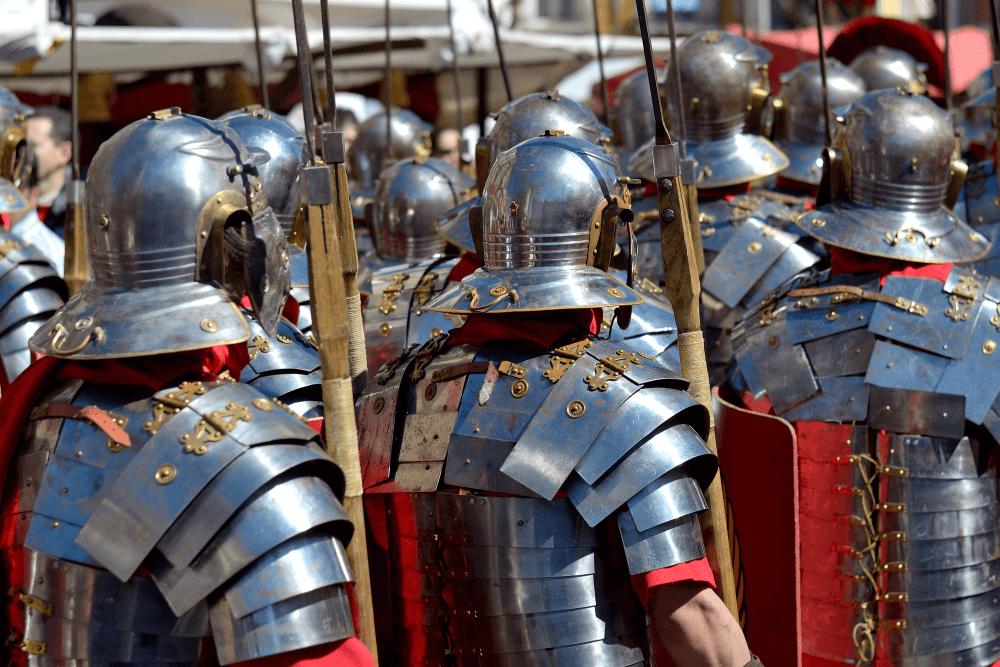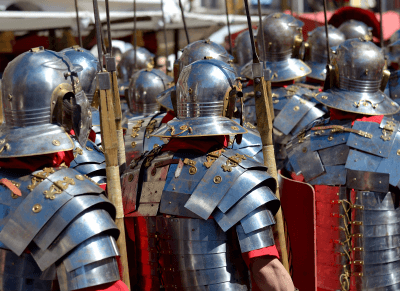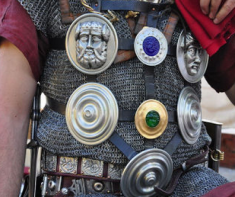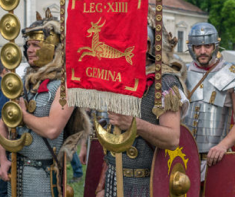The Roman legion was the backbone of the Roman army, a formidable military force that conquered much of the known world. It was a highly organized and disciplined fighting force that played a crucial role in the expansion and maintenance of the Roman Empire.
On this page, we'll explore the history and structure of the Roman legion, its tactics and weapons, and its legacy in military history.
Organization and Ranks of the Roman Imperial Legion
During the Imperial period, a full strength legion was officially made up of 6,000 men, but typically all legions were organized at under strength and generally consisted of approximately 5,300 fighting men including officers.
It is difficult to determine whether non-combatants like field surgeons and clerks were included in this 5,300 or helped bring the total number of men up to the official 6,000.

In this section, we look at the overall fighting strength of a Roman Imperial legion, how it was organized, and the many different ranks of those within it.
The basic structure of the army is as follows:
- Contubernium (tent group): consisted of 8 men.
- Centuria (century): was made up of 10 contubernium with a total of 80 men commanded by a centurion.
- Cohorts (cohort): included 6 centuriae or a total of 480 fighting men, not including officers. In addition, the first cohort was double strength but with only 5 centuriae instead of the normal 6.
- Legio (legion): consisted of 10 cohorts.
Additionally, each legion had a 120 man Alae (cavalry unit) called the Eques Legionis permanently attached to it, possibly to be used as scouts and messengers.
Individual legions were identified using Roman numerals, often with an additional name or title. This could refer to the region where they were based (e.g. Legio IV Macedonia), or an emperor (e.g. Legio II Augusta).
Occasionally, the name of a legion was changed to a word in recognition of an event. For example, Legio VI Hispaniensis was renamed Legio VI Victrix for exemplary service in quelling the entire region of Hispania.
How Many Soldiers in a Legion?
The First Cohort totaling 800 men (5 double-strength centuries with 160 men each) 9 Cohorts (with 6 centuries at 80 men each) for a total 4,320, and an additional 120 man cavalry for a grand total of 5,240 men in a Roman Legion of the Imperial period, not including all the officers.
The basic designation of the 10 cohorts was the same throughout all the Legions. They were arranged in battle so that the strongest and weakest units would be mixed throughout the formation maximizing moral and effectiveness.
- Cohort I: Was made up of the elite troops. Its direct commander was the Primus Pilus, the highest ranking and most respected of all the Centurions.
- Cohort II: Consisted of some of the weaker or newest troops.
- Cohort III: No special designation for this unit.
- Cohort IV: Another of the four weak cohorts.
- Cohort V: Again, no special designation.
- Cohort VI: Made up of "The Finest of the Young Men".
- Cohort VII: One of the four weak cohorts and a likely place to find trainees and raw recruits.
- Cohort VIII: Contained "The Selected Troops".
- Cohort IX: One of the four weak cohorts and a likely place to find trainees and raw recruits.
- Cohort X: Made up of "The Good Troops".
Roman Military Ranks
The following list indicates ranks and hierarchy structure from highest command to lowest common soldier in the Roman army:
Senior Officers of the Roman Legion
Legatus Legionis
The overall Legionary commander. This post was generally appointed by the emperor, was a former Tribune and held command for 3 or 4 years, although could serve for a much longer period.
In a province with only one legion, the Legatus was also the provincial governor and in provinces with multiple legions, each legion has a Legatus and the provincial governor has overall command of them all.
Click here for more information about the Legatus LegionisTribunus Laticlavius
Named for the broad striped toga worn by men of senatorial rank. This tribune was appointed by the Emperor or the Senate.
Though generally quite young and less experienced than the Tribuni Angusticlavii, he served as second in command of the legion, behind the Legate.
Praefectus Castrorum
The camp Prefect. Generally he was a long serving veteran who had been promoted through the ranks of the centurions and was third in overall command.
Click here for more information about the Praefectus CastrorumTribuni Angusticlavii
Each legion had 5 military tribunes of equestrian (knight) class citizens. They were in many cases career officers and served many of the important administrative tasks of the Legion, but still served in a full tactical command function during engagements.
Primus Pilus
The "First Javelin" was the commanding centurion of the first cohort and the senior centurion of the entire Legion. Service in this position also allowed entry into the equestrian social class upon retirement.
Click here for more information about the Primus PilusMid-Level Officers in the Roman Legion
Centurions
Each Legion had 59 or 60 centurions, one to command each centuria of the 10 cohorts. They were the backbone of the professional army and were the career soldiers who ran the day to day life of the soldiers as well as issuing commands in the field.
They were generally moved up from the ranks, but in some cases could be direct appointments from the Emperor or other higher ranking officials.
The cohorts were ranked from the First to the Tenth and the Centuria within each cohort ranked from 1 to 6, with only 5 Centuria in the First Cohort (For a total of 59 Centuria and the Primus Pilus).
The Centuria that each Centurion commanded was a direct reflection of his rank. Command of the First Centuria of the First Cohort was the highest and the 6th Centuria of the 10th Cohort was the lowest. The 5 Centurions of the First Cohort were called the Primi Ordines, and included the Primus Pilus.
Pilus Prior
The commander of the first cohort of each Centuria (except the first), with the following titles for the Centurions in sequence throughout each Centuria.
- Pilus Posterior
- Princeps Prior
- Princeps Posterior
- Hastatus Prior
- Hastatus Posterior
Low-Level Officers in the Roman Legion
Principales
The Principales would be the equivalent of modern day non-commissioned officers and had the following rank structures from highest to lowest:
Aquilifer
A single position within the Legion. The Aquilifer was the Legion's Standard or Eagle bearer and was an enormously important and prestigious position. The next step up would be a post as a Centurion.
Signifer
Each Centuria had a Signifer (59). He was responsible for the men's pay and savings, and the standard bearer for the Centurial Signum, a spear shaft decorated with medallions and often topped with an open hand to signify the oath of loyalty taken by the soldiers. It was this banner that the men from each individual Centuria would rally around.
A soldier could also gain the position of Discentes signiferorum, or standard bearer in training.
Optio
One for each Centurion (59), they were appointed by the Centurion from within the ranks to act as his second in command.
Tesserarius (Guard Commander)
Again there were 59 of these, or one for each Centuria. They acted in similar roles to the Optios.
Cornicen (Horn Blower)
They worked hand in hand with the Signifer drawing the attention of the men to the Centurial Signum and issuing the audible commands of the officers.
Imaginifer
Carried the Standard bearing the image of the Emperor as a constant reminder of the troop's loyalty to him.
The Rank and File of the Roman Legion
Immunes
These were trained specialists, such as surgeons, engineers, surveyors, and architects, as well as craftsmen. They were exempt from camp and hard labor duties due to the nature of their work, and would generally earn slightly more pay than the Milites.
Discens
Milites in training for an immunes position.
Munifex (or Miles Gregarius)
The basic private level foot soldier.
Tirones
The basic new recruit. A Tirones could take up to 6 months before becoming a full Milites.
Basic Legionary Equipment

On the march the Legionary could carry between three and fourteen day's worth of rations, a saw, a wicker basket, a piece of rope or leather, a shovel, a waterskin, a sickle and a pickaxe.
Each of these items, aside from the pickaxe which was worn on the belt, was carried on a forked pole introduced by Gaius Marius called the pila muralia, which earned his men the nickname Marius' Mules.
There is some discrepancy over what was actually carried and the possible total weight. At times, some items may have been transported in wagon trains or on mules such as the legionaries' tents and millstones for grinding the corn rations.
It has been estimated that a legionary could carry anywhere from 66 lbs. (30 kgs) to over 100 lbs. (45 kgs) of gear and weapons, with Roman armor and shields being particularly heavy.
Balteus or Cingulum Militare
The standard belt. It was rather narrow and typically decorated with bronze strips, that were sometimes tin-plated, all the way around.
Bracae
While Romans considered the wearing of pants or trousers to be against any standard code of dress, legionaries in cold climates were allowed to wear wool or leather skin tight trousers that reached just below the knee.
Buccellatum and Frumentum
Hard tack and corn rations. Baked rock hard to remove all moisture, it could therefore last a long time without going off, making it perfect for long military campaigns.
Caligae
Heavy military sandals that used iron hob-nails as treads, similar to modern day athletic cleats. The leather thongs continued half way up the shin and tied there, and in cold weather could be stuffed with wool or fur. Eventually these would be replaced by a heavier style of actual boot.
Caligae was also the term from which the Emperor Gaius (Caligula) got his nickname. He was the son of the enormously popular Legate Germanicus and accompanied his Legions on several northern campaigns. As a boy, the Legionaries saw him as a good luck mascot and called him Caligula for "Little Boots".
To find out more, check out our page on Roman Sandals.
Focale
Metal armor may provide much needed protection, but it can be extremely uncomfortable, particularly when worn for long periods of time. The focale was a scarf made of wool or linen, worn to keep the metal of the armor from scraping and chafing the neck.
Galea
Helmet. Though there were many types this was the most common helmet, the Imperial Gallic along with the Imperial Italic. They were generally made of bronze with iron trim, with a projecting piece shielded the neck and a smaller ridge fastened at the front for protection of the face. At the sides were large cheek pieces hinged at the top.
Find out more information by visiting our Roman Helmets page.
Papilio
A leather tent, usually made out of calfskin or goatskin, which would protect the soldiers from the elements when sleeping. These would often sleep between six and eight soldiers each.
Scutum
The large Roman shield, which was curved to fit the body. They were made from thin sheets of wood, glued together so that the grain of each piece was at right angles to the piece next to it.
The whole was bound around the edges with wrought iron or bronze and the center was hollowed out on the inside for the handgrip and protected by metal bands.
On the outside, the surface was covered in leather, on which was fastened gilded or silvered decoration, probably in bronze.
Each cohort had different color schemes to aid recognition during a battle. The shields also carried the name of the soldier and that of his centurion. On the march, the shield was hung by a strap over the left shoulder.
Find out more information by visiting our Scutum page.
Sporran
The apron consisted of a number of leather thongs to which were riveted metal plates, and weighted with bronze. It could have been either decorative, protection for the genitals or a combination of both.
Tunica
The standard tunic worn over linen undergarments and underneath a legionary's armor. These were red, it is thought, so that the enemy would not be able to easily see a legionary bleed if wounded during battle.
Body Armor
Lorica Hamata
Chain mail that was used extensively throughout Roman history and well after its fall. It provided excellent protection and flexibility, but was very heavy and time consuming to make.
Lorica Segmentata
Plate Armor. A name translated by modern scholars, as we don't know what the Romans actually called it. This armor was made up of many pieces of laminated iron all bound together to form a very flexible, strong and the most effective of Roman body protection.
It seemingly replaced chain mail as the favored Legionary issue, but due to budgeting constraints its length of service seems to have been a relatively short period of time (roughly Rome's golden era in the early empire and through the late 2nd century).
Loricae Squamatae
Scale Armor, actually translated to Armor of Feathers. Scale armor consisted of row upon row of overlapping bronze or iron scales, which resembled a coat of feathers.
Scale seemingly began to replace Plate late in the 2nd Century CE, as it was easier and less expensive to make than the other forms, but was less flexible and is often considered far less capable.
Common thought is that it was especially vulnerable from an upward stab, but this theory is highly debated.
Weapons
Gladius
The Roman short sword. It was a double-edged weapon about 18 inches long and two inches wide, often with a corrugated bone grip formed to the Legionaries hand. A large round ball at the end helped with the balance.
The primary use was for thrusting at short range. It was carried high on the right hand side so as to be clear of the legs and the shield arm.
Pilum
The Roman javelin. It was seven feet long and very light, as it was thrown before just prior to engaging the enemy in melee, to disarm as much as wound them. The top three feet were of iron with a hardened point.
It is probable that more sturdy types of spear of the same name were available for defense against cavalry in formation such as the turtle.
For more information on the Pilum, please click here
Pugio
The Roman dagger was anywhere from 7 to 11 inches long in similar width to the gladius. It could be highly decorative or very plain, but was a very useful secondary weapon in case of being disarmed. It was attached to the belt on the left hand side.
For more information on the Pugio, please click here
Centurion Equipment
A centurion's equipment was notably different from that of a legionary. He wore a transverse, side to side, crest along his helmet that would serve as an easily recognized point of reference for the men. The crest was made either of feathers or horsehair and colors could signify various ranks.
Rather than the Lorica Segmentata of the Legionary, they would wear either chain or scale. It was generally about waist length with a lower edge similar to the muscled cuirass.
The armor and helmet could be silver-plated as well. He did not wear the apron like the Legionary but had a double-pleated kilt like piece. They also wore a cloak, of fine material, which hung from the left shoulder and a very ornate belt.
Additionally the wearing of bronze greaves on the shins set them apart from the rank and file. They generally wore their swords on the left and daggers on the right, opposite of the common soldiers. They carried a Vitis, vine staff, in his right hand as a symbol of his rank. It was made of grapevine and about 3 feet long.
Officer Equipment
Officers could, of course, dress very differently from anyone else and there seems to be set pattern to the styles. They did have very fine dyed cloaks of various colors to signify rank. They generally wore a muscled cuirass and used a parazonium instead of a gladius; both described below.
Lorica Musculata
The muscled cuirass was a bronze chest piece made in two pieces, one for the front and one for the back, and buckled together at the sides. These were well decorated with animal, mythological and chest muscle designs.
Parazonium
The more ornate sword carried by officers, the hilt of which could be in the form of an eagle head, or lobed. It can be slung on a narrow shoulder baldric but is more often simply cradled in the left arm, and the fingers of the left hand can be forked over the lobed pommel.
Pteruges
Straps that hung off the shoulders and waist and covering the upper arms and legs, were made of leather. They were implemented to protect the arms and legs, while conserving the use of metal.

Did you know...
Until the reign of Septimius Severus, soldiers were forbidden to be legally married while serving, though of course many had local girlfriends, common-law wives, and children.
Did you know...
The equipment to the legionaries was remarkably uniform throughout the empire and it is possible that there were large centres in Gaul and North Italy for the mass manufacture of helmets, armor and weapons.






Legions of Rome: The Definitive History of Every Imperial Roman Legion
by Stephen Dando-Collins
Featuring more than 150 maps, photographs, diagrams and battle plans, Legions of Rome is an essential read for ancient history enthusiasts, military history experts and general readers alike.